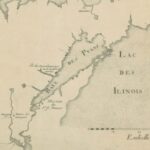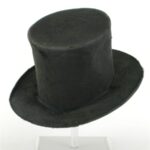French explorers, voyageurs (fur traders), Jesuit priests, and other settlers began arriving in the Upper Great Lakes region of North America in the mid-1600s. Jean Nicolet supposedly landed near present-day Green Bay, Wisconsin in 1634, naming the waterway La Baye des Puants, literally “Bay of Bad Odors.”It was not until the 1680s, however, that the French would gain a firm foothold in the territory, led primarily by commandant Nicholas Perrot, and the Jesuit priest Claude Allouez.
In 1721 the fort was under the command of Sieur de Montigny, who stayed for three years during which time the settlement saw relative peace and productive trade. That quickly changed in 1728 when the French burned their fort under the command of Lieutenant de Louvigny, in an effort to ensure it would not fall into the hands of the Fox Indians during the second Fox War. After somewhat peaceful relations were established with the Fox people (aka Renard), the fort was rebuilt in 1731 under the command of Sieur de Villiers. Maintaining control of the fur trade in Green Bay was difficult for the governors of New France, due to illegal trading, as well as frequent skirmishes with native populations. However, by 1717 historical sources confirm the presence of a fort at Green Bay at the mouth of the Fox River. This fort under French occupation was variously called Fort St. François and Fort La Baye. Its location near the confluence of the Fox River and Green Bay was a strategic choice to control trade between the Great Lakes and the Mississippi River. The fort established New France’s legitimacy in the region and offered protection for the soldiers stationed there.
By the 1750s, the fort’s population had reached approximately 200, including both French and Métis (mixed native and European) families. Due to its geographical isolation from Montreal and Quebec, French officials regarded La Baye as one of the most difficult settlements to inhabit, and its fur trade one of the most difficult to control. French cartography and navigational tools like the Le Maire Sundial Compass were crucial in the French effort to maintain their presence in upper New France during the eighteenth century.

The last French soldier in command of Fort La Baye was Captain Beaujeu de Villemond, also commandant of Michilimackinac (Mackinac Island and surrounding straits). In October 1760, Beaujeu learned of the French surrender to the British army in Montreal from Charles de Langlade, Wisconsin’s first permanent European settler. Beaujeau evacuated Michilimackinac stopping at Fort La Baye.
Written by Kevin Cullen, December 2016.
SOURCES
Brendon Baillod, “The Mystery of The French Sundials.” Wisconsin’s Underwater Heritage Vol. 21, No. 4 (2011): 1, 4-7.
H.R. Casgrain, Journal du Marquis de Montcalm Durant Ses Campagnes en Canada de 1756 à 1759. Quebec: Imprimerie de L.J. Demers & Frère, 1895.
Louise Phelps Kellogg, The French Regime in Wisconsin and the Northwest. Madison: The State Historical Society of Wisconsin, 1925.
Nancy Lurie and Patrick Jung. The Nicolet Corrigenda: New France Revisited. Long Grove, IL: 2009.
Deborah Martin, History of Brown County Wisconsin Past and Present, Vol. I. Chicago: The SJ Clarke Publishing Company, 1913.
Jacqueline Peterson, “Ethnogenesis: The Settlement of a ‘New People’ in the Great Lakes Region, 1702-1815.” American Indian Culture and Research Journal Vol. 6, No. 2 (1982): 23-64.
This Post Has One Comment
Comments are closed.





I made a trip to Green Bay, Wisconsin about 20 years ago to see the statues of a member of the Fox tribe, French Jesuit Claude Allouez and commandant (later governor) Nicolas Perrot. Nicolas Perrot was related to me but over the years, the name Perrot was changed to Perreault. My maiden name is Carole Perreault, and my father’s name was Odilon Perreault.
I was told that Nicolas Perrot was instrumental in stopping a war between the indiginous and the French at Lac des Chats…..but I do not have more information on the subject. Nicolas Perrot was commissioned by the King of France in circa 1641 , to open up trading posts in the area….